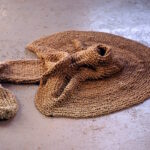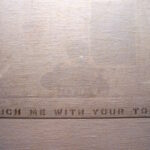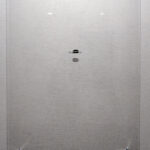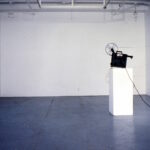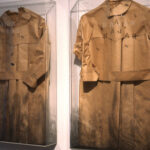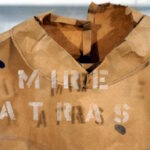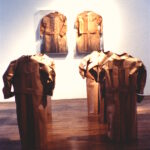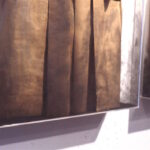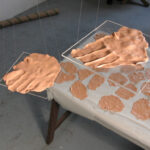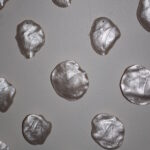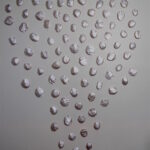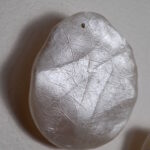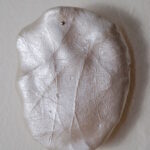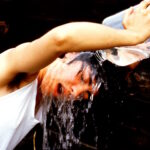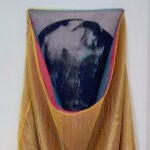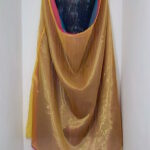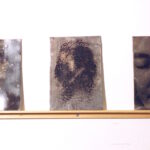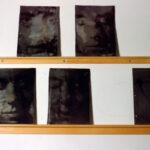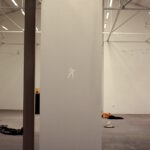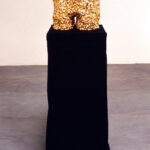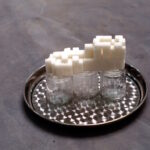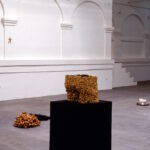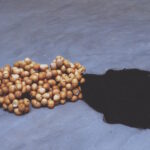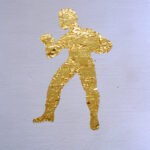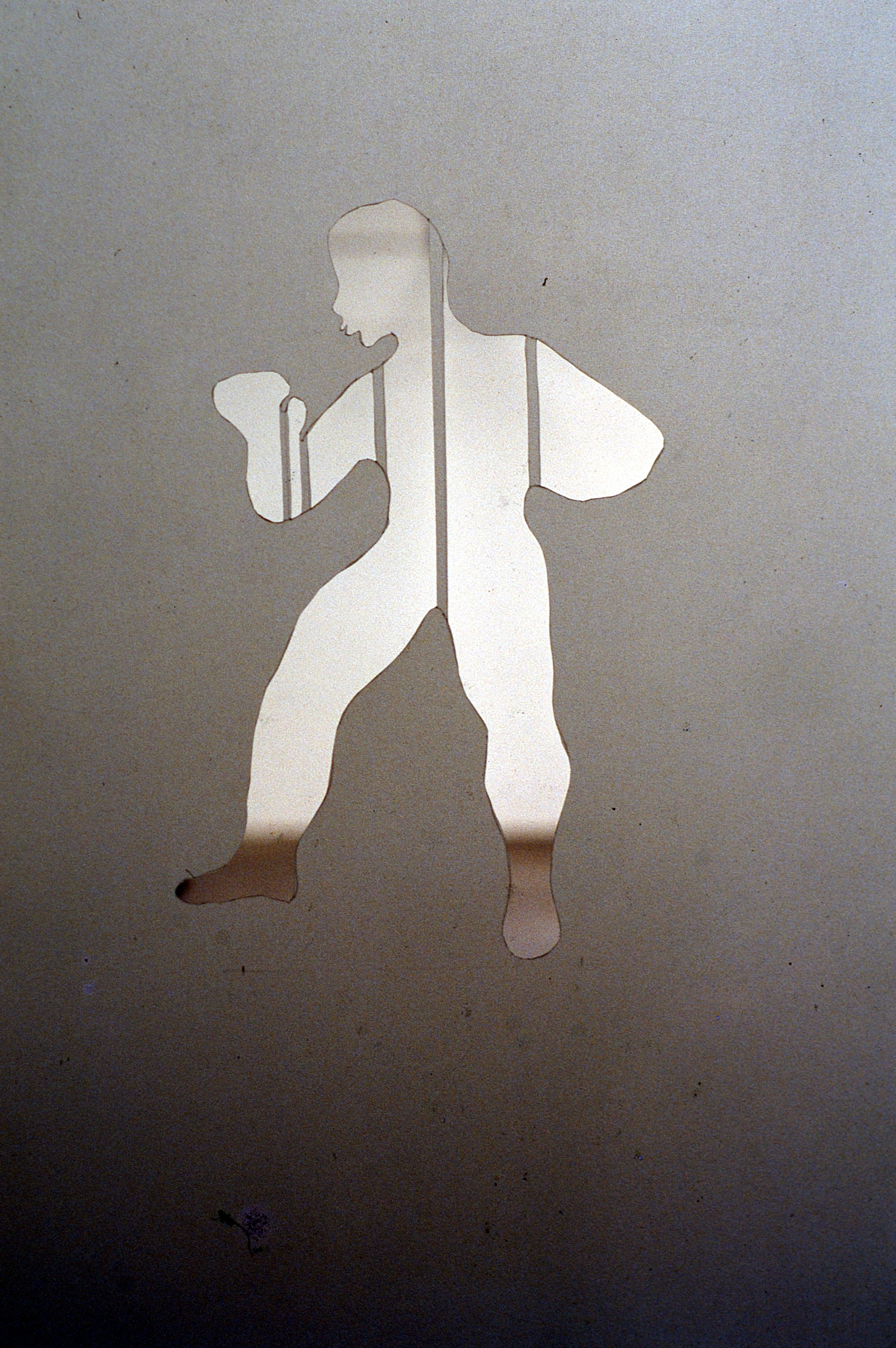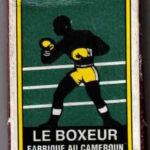Zona Franca Blog
About: Zona Franca Blog
March 1, 2025This blog is a space to reflect on art and art making. It also presents and puts into context older work.
In the Flesh / En chair et en os
At : Produit Rien
6909 rue Marconi, Montréal, H2S 3K2
Vernissage: November 29th, 2023-12 to 5pm
Closing with performance: December 3rd, 2023
Performance: 3pm
About three years, almost 4 years now I started working with Big-Bang, a dance academy in Montreal. I have designed a series of workshops around ideas of performance. The base of the ‘activities’ has been moving with materials and objects that I bring to the participants.
Eventually, it did not take long to think of using my sculpture in the same way. This is part of this research. Léonie Belanger and my daughter Laura Borello-Bellemare joined me in this work, and they brought their on wonderful experience in contemporary dance to the task.
In The Flesh presents six sculptures that find their way into six photographs. The photographs capture women’s bodies wearing, carrying, inhabiting, manipulating the sculptural works. The vulnerability of these bodies, exposed but strong in their framing, proposes an inquisitive narrative exploring the question: what should be done with these objects?
The sculptural pieces in themselves have been an exploration of how to inject symbolic meaning into mass-produced articles, specifically products and materials found in the ubiquitous dollar store, but also in the hardware store, and the notion’s store.
I have transformed the banal domestic objects into sculptural art-works connected to ideas and feelings related to my body and my bodily experiences.
This manipulation and handling of the sculptures by the bodies, tell a story of a deeper connection, which is performative in nature and revelatory of youth and aging; furthermore, it talks of bodies as a source of pleasure and pain, disguise and confrontation. At the end, I see us in the flesh, me and them, able to pose but unable to move, vulnerable but aware of a strength that keeps us looking at ourselves.
……………………………………………………………
En chair et en os
En chair et en os comprend six sculptures qui se retrouvent en six photos. Ces images illustrent des corps féminins qui portent et transportent les pièces sculptées, les habitent et les manipulent. La vulnérabilité de ces corps, à la fois exposés et fortement encadrés, proposent un narratif interrogatif, presqu’inquisiteur : quelle est donc la destinée de ces objets ?
Ces sculptures sont elles-mêmes une tentative d’infuser une signification symbolique à des articles de fabrication industrielle qu’on trouve par exemple aux magasins à un dollar, en quincaillerie ou en mercerie. J’ai transformé ces articles de la banalité domestique en sculptures liées à des idées ou émotions issues de mon propre corps, ou de ses fonctions corporelles.
Le traitement que subissent ces sculptures traduit un lien plus profond, de nature performative et révélatrice de la jeunesse et de la vieillesse. De plus, elles interprètent les corps comme sources de plaisir et de douleur, de déguisement et de confrontation. En somme, je nous vois en en chair et en os, eux et moi, capables de prendre la pose mais incapables d’en sortir; à la fois vulnérables mais conscients de la puissance permettant cette auto contemplation.
It is a work made of crocheted ball chain. Ball chain is a versatile material and crocheting with it created an unusual result. I knitted a closed tubular shape opening up into a flower like shape. The piece can be displayed in various configurations, and can be manipulated.
The work is hermaphrodite, by that I mean that it has both a phallus like shape, the tubular shape mentioned above, and an opening like flower shape mimicking a vulva.
The crocheting refers to traditional domestic feminine activities, but here a non-traditional material is used, one that is found in a hardware store. The viewer is encouraged to manipulate the work, to be able to feel its weight and form it into various shapes.
This piece had never been exhibited in a gallery setting, until November 2023, when it was presented at Produit Rien in the exhibition In the Flesh / En chair et en os.
Found Object is a piece whose name makes reference to the artist’s find of a shaving blade marketed for women, with the brand named Nymph. The actual packaging stated that it was a ‘lady’s blade’.
The blade is glued on the front of a piece of acrylic about 30 by 42 inches. The pane of acrylic is attached three inches from the wall with metal hardware. The text Touch me with your tongue is etched at the bottom of the acrylic creating a shadow on the wall. Lady’s Blade is written on the wall behind the razor.
The piece functions within a feminist reading of the public and a private spheres. The public voice speaks of a status quo, authoritarian and violent, whose main desire is the molding of woman into submissive, nymph-like creatures. The intimate, private voice is represented by the invitation: Touch me with your tongue, which should be sensual but it is also a violent refusal to conform. Are we invited to touch the blade with our tongues?
Seeing Things, 1992, was part of my final MFA show at Concordia University. The piece was later shown at La Central/Powerhouse.
The work is made out of four elements: a 16 mm projector, and a 16mm film on a loop, the actual projected image on a wall and the presence of an industrial fan turned on. The projector and the fan’s noise are part of the installation. The fan is on looking at the back of the projector and blowing into the projected image.
The Bourget Building where the MFA program was housed at the time had left over old objects around the studios, and the fans were some of them. This is a large industrial standing metal fan with a diameter of approximate 30 inches.
With the help of another student in the program, EA, I had shot a black and white, short 16mm film of myself, just the eyes, blinking as if something was disturbing my vision.
I am particularly fond of this piece as it navigates absence and presence, reality and illusion, fiction and representation.
The eyes are reacting to an exterior force that is taking place in a different time and space.
Palomitas Blancas, 1994
(Each uniform: 48 x 18 x 14 inches approx.)
(Each box: 48 x 18 x 6 inches)
Palomitas Blancas (Little White Doves) was produced in Argentina, after I received one of my first creation grants. The work is directly related to my experience of exile. It is probably one of the few pieces that speak in such an autobiographical manner bringing childhood memories and the experience of immigration together. Children wearing the white uniforms would be called in popular vernacular as “Little White Doves”.
The work is made of two sets of uniforms. On the floor a group of six uniforms made out of Kraft paper, life size, standing like in a vigil, in two rows. The uniforms are modeled after the white uniforms used by girls in the public education system, most of the time at the elementary level. I worked from the actual patterns to cut them out and machine sewn them like if I was working with a fabric.
On the wall, placed at eye level, there is a second set of uniforms encased on two acrylic boxes, housing one uniform each. There is powder graphite, inside at the bottom of the boxes, and fingerprints marks on the acrylic. Each box has an etched message on the surface, ‘Mira atras’ and ‘Al bajar’: this translates as ‘Look Behind’ and ‘When You Step Down’. This sign is found on the back door of public city buses to warn people to be careful of potential upcoming traffic; buses would not always stop close to the curve.
I use this sign to speak of history, of how as citizens we must look back continuously at the past if we want to understand our present and our future.
The work speaks of absence and of presence revealing different levels of meaning and of understanding of the experience of violence and immigration.
Lifeline / Línea de vida, 2005-20
Palm reading’s origins are very old, and I have always found it fascinating. The most important lines to be read on a palm are: the line of life, of the heart, of the head and the fate line. For this work I zeroed on the life line by taking the imprint of my left hand palm and reproducing it. In a sense the imprint is the negative of a positive.This work is not part of my site, nor has ever been presented publicly.
The work has gone through different versions. The first was unstable as I used ‘skin’ tone plasticine. I wanted that fragility to come through. I had designed it to be shown on hanging acrylic shelves.
Then I started working with another material that could be baked and make it more stable. This was interesting, now the imprint was fixed. I used smaller round pieces of the material creating a sort of small shell. Interestingly enough I think that was what made some people cringed. It created other references of actual kitsch work, in and around seashells. That reference was not there for me. As I finished painting them silver, they had become something else. The work for me was strengthened by the paint. This last version of the work presents it as an installation, which has each perforated piece, pinned against a wall, creating a funnel shape. Each piece is unique.
The attached documentation shows examples of the two versions of the work.
To have part of my body presented as such is a powerful gesture. This is tied to work I did on fingerprints, on photographing my tongue and my face. All of these are different ways to define identity and self. I do think all of this work comes out of my experience as an immigrant, a continuous definition of the self.
This work was produced following a series of events. On one hand there was a friend with access to a print shop right in the middle of the pandemic. Also, I had been working with dancers, on performance workshops and had brought fabrics for them to work with. Some of the fabric was stretchy, some was semi transparent, and I had gone to a seamstress to join them to create something the dancers could get inside and be able to move. And I had these images of my face from way back; images used on a performance that I thought could work for the prints.
So, we went ahead Stefan and I, and he had the semi transparent fabrics silkscreened with one particular image. I wanted the same image printed, to see how they worked in the different colors. Suddenly the work started to have a life of its own, and I realized I had to overlap the fabrics and voilà! the piece was there. By overlapping the fabrics it created a depth in the image, and it became more than I had planned at the beginning. I ended adding fishing lines to the exterior fabric. The work hangs now at home, in the space facing the stairs to the basement: it has found its place.
I decided to use the words from a Talking Head song as the title.
I want to thank Stefan Hoffmann (printing) and Jennifer Drysdale (photography) for their work.
Mother Tongue/ Lengua Madre, 1991
I produced Mother Tongue 30 years ago (!), towards the end of my MFA at Concordia University. At the time my friend KF and I had created a dark room out of a closet in the Bourgeois building. Under strange administrative reasons during those years, being part of an open graduate program that had no link to an undergraduate one, left us unable to use the darkroom in the VA building, or any other shop for that matter. So, we made our own.
In retrospect it probably was very toxic, and I don’t remember if we used masks, on top I started using ‘liquid light’ on lead, doubling the toxic possibilities probably! KF reminded me a while ago that my experience working in the photo lab at OCAD in Toronto came in handy. I knew what to buy and to how to mix the chemicals for developing and printing black and white.
Mother Tongue is made out of a series of approx. 20 lead panels seven by five inches and about ¼ of an inch thick. As I mentioned, I used liquid light (a chemical that makes any surface light sensitive) to develop black and white photographic images on top of the lead. These panels would sit on wooden ledges; the configuration would vary depending on where it was installed.
The images in the lead pieces are of my face with the eyes close, of my face with the eyes open, of my tongue and of my thumbprint: all elements to confirm identity. The photographic images sat very unevenly on the surface of the lead creating differences with each image.
This work was exhibited at Articule, in Montreal in a group show where three curators had chosen three artists of the community. It travelled to AKA’Artist Centre in Saskatoon as part of a show I had titled ‘Heavy Stitching’, and my friend DB took the work to Mexico along side other works from Montreal artists. Somehow some of the pieces have been ‘lost’, I don’t know how that happened, but I was neglectful to check that they were all there every time the work came back from its travels.
I am particularly found of the work as I think it is one of the strongest works where I combined my feelings of exile tied to my identity as an artist and a woman.
Le boxeur se prépare, ses vêtements attendent dans la salle/
The boxer gets ready, his clothes wait in the room, 1999.
Documentation of this piece can be found in the site under past works, but I felt I wanted to bring this installation to the forefront. It is a work that has stayed with me after all of these years.
François (my husband) and I had at that point been in Cameroon for at least for one year. We had come to central Africa with a contract Francois had obtained with Oxfam Quebec. I was unable to do the same, but I wanted to stay busy and useful. I did volunteer work teaching at two different institutions, a wonderful experience that helped me improve my French on the way.
At the same time, it was important for me to connect with local artists. I reached out to the different art institutions and that included Espace Doual’art, in the city of Douala. Princes Marylin Douala and the late Didier Schaub speared headed Doual’art, a center of the arts, education and communication that had already made a big impact on the city of Douala for the better, and it continues to do so. At one point Doual’art offered me the possibility of presenting my work. Our daughter had already been born, and I produced the whole installation in her company.
The work was inspired by an image of a boxer on a matchbox easily found in the 90’s in Cameroon. The installation is made out of six elements. There are two images of the boxer; one in imitation gold leaf and the second one is a cut out figure at the entrance of the gallery. The other four elements are objects that make direct reference to the boxer’s clothing: a shoe, a boot, a glove and shorts. Every piece in the installation has its own particularity and presence, but each is somehow dysfunctional.
I wanted to use materials easily found in African markets: recycled rubber inner tubing which is used to tied things up, white sugar, egg-shells coming from the local egg production, false hair from the many hairdressing saloons and hand made cut gravel. Ebolowa, the city where we lived, has about 40,000 inhabitants and is located about 1h30h from the capital of Yaounde (and 3 hours from Douala). Outside of the city center, by specific rock sediment, we had encounter adults and children spending their days under a small hut, chipping on the gravel rock with small hammers. They will sell their work to local construction companies.
The activity of making gravel by hand had made an impression on me, and I wanted to use their work in one of the pieces. I bought a few pails of the gravel to build the shorts of the boxer, and then I used imitation gold leaf to cover its exterior. It is the only piece that I placed on a pedestal. All the other works were placed on the floor.
The boot was made of long rubbers pieces that occupied a large space on the floor ending on the actual boot, built by knitting the rubber the rubber pieces, and it is about three feet in length.
The shoe (standard size 10 man) is made of sugar cubes glued together, sitting on a serving tray with water around it.
Further in the gallery, there was a large object close to three feet in length made out of eggshells, with long pieces of dark false hair. It was not obvious but the eggshell object was meant to be one of the boxer’s gloves, with false hair at the end.
As I mentioned before there was an image of the boxer on the wall in front of the installation of about 12 inches in height made out of imitation gold leaf. And as one entered the installation I had hang a long piece of tracing paper and cut out the image of the boxer also of about 12 inches in height.
The day after the opening of the show, the gallery organized a discussion around the work in the presence of the public and many artists of the community. For me at the time, it was an invaluable opportunity to make a deeper connection with local artists; an enriching experience overall.
Every three years or so, since 2007 Doual’art has organized SUD the Salon Urbain de Douala. I was honoured to participate in 2010 with two different shows: an installation at the gallery in January of that year, and then a video projection out side the gallery in December 2010 in the middle of the actual Salon and the other works being presented.
